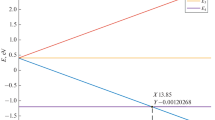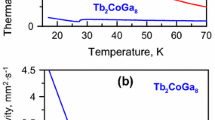Abstract
Taking into account the inexhaustible interest in studying the peculiarities of physical properties in the neighborhood of phase transitions and the growth of experimental investigations of cobalt fluoride, we have studied the peculiarities of magnetic susceptibility in the vicinity of the critical field HC at which cobalt fluoride performs the second-order phase transition from the antiferromagnetic phase to the angular phase. It is discovered that in the magnetic field H ‖ C4, the magnetic susceptibility becomes infinite at H → HC. It is shown that as the magnetic field direction deviates from the C4 axis, the magnetic susceptibility in the critical field HC proves to be finite. It is also shown that the change in the magnetic susceptibility with the change in the magnetic field considerably decreases at extremely insignificant deviations of the field H from the C4 axis. Since the calculations are performed in terms of the Landau theory of phase transitions, we pay attention to the similarity and difference between the obtained results and those in the vicinity of the Curie point obtained by using the Landau theory of phase transitions.
Similar content being viewed by others
References
L. D. Landau and E. M. Lifshitz, Course of Theoretical Physics, Vol. 5: Statistical Physics (Nauka, Moscow, 1995; Pergamon, Oxford, 1980).
L. D. Landau and E. M. Lifshitz, Course of Theoretical Physics, Vol. 8: Electrodynamics of Continuous Media (Nauka, Moscow, 1982; Pergamon, New York, 1984).
A. D. Bruce and R. A. Cowley, Structural Phase Transitions (Taylor and Francis, London, 1981).
H. E. Stanley, Introduction to Phase Transitions and Critical Phenomena (Oxford Univ., Oxford, New York 1971; Mir, Moscow, 1973).
A. Patashinskii, V. Pokrovskii, and P. J. J. Shepherd, Fluctuation Theory of Phase Transitions (Pergamon, Oxford, 1979; Nauka, Moscow, 1975).
V. N. Ryzhov, E. E. Tareyeva, Yu. D. Fomin, and E. N. Tsiok, Phys. Usp. 60, 857 (2017).
A. N. Utyuzh and A. V. Mikheyenkov, Phys. Usp. 60, 886 (2017).
E. I. Kats, Phys. Usp. 60, 949 (2017).
V. V. Brazhkin, Phys. Usp. 60, 954 (2017).
T. R. Dugan, J. M. Goldberg, W. W. Brennessel, and P. L. Holland, Organometallics 31, 1349 (2012).
Y. T. Teng, S. S. Pramana, J. Ding, T. Wu, and R. Yazami, Electrochim. Acta 107, 301 (2013).
M. J. Armstrong, A. Panneerselvam, C. O’Regan, M. A. Morrisab, and J. D. Holmes, J. Mater. Chem. A 1, 10667 (2013).
C. Y. Lee, Z. Su, K. Lee, H. Tsuchiya, and P. Schmuki, Chem. Commun. 50, 7067 (2014).
M. C. Leclerc, J. M. Bayne, G. M. Lee, S. I. Gorelsky, M. Vasiliu, I. Korobkov, D. J. Harrison, D. A. Dixon, and R. T. Baker, J. Am. Chem. Soc. 137, 16064 (2015).
J. Tan, L. Liu, S. Guo, H. Hu, Z. Yan, Q. Zhou, Z. Huang, H. Shu, X. Yang, and X. Wang, Electrochim. Acta 168, 225 (2015).
O. G. Medvedovskaya, T. A. Fedorenko, and G. K. Chepurnykh, Phys. Solid State 58, 2438 (2016).
N. F. Kharchenko, V. V. Eremenko, and L. I. Belyi, Sov. Phys. JETP 55, 490 (1982).
K. G. Gurtovoi, A. S. Lagutin, and V. I. Ozhogin, Sov. Phys. JETP 56, 1122 (1982).
G. K. Chepurnykh, Regions of Extremal Characteristics of Magneto-Ordered Crystals (Naukova Dumka, Kiev, 2010) [in Russian].
K. P. Belov, Soros. Obrazov. Zh. 3, 15 (1998).
L. D. Landau and I. M. Khalatnikov, Dokl. Akad. Nauk SSSR 94, 469 (1954).
S. V. Peletminskii, Sov. Phys. JETP 10, 321 (1959).
Author information
Authors and Affiliations
Corresponding author
Additional information
Original Russian Text © G.K. Chepurnykh, V.A. Chernaya, O.G. Medvedovskaya, 2018, published in Fizika Tverdogo Tela, 2018, Vol. 60, No. 9, pp. 1669–1673.
Rights and permissions
About this article
Cite this article
Chepurnykh, G.K., Chernaya, V.A. & Medvedovskaya, O.G. Anomalies in the Magnetic Susceptibility in the Second-Order Phase Transitions beyond the Curie Point. Phys. Solid State 60, 1712–1717 (2018). https://doi.org/10.1134/S1063783418090068
Received:
Published:
Issue Date:
DOI: https://doi.org/10.1134/S1063783418090068




